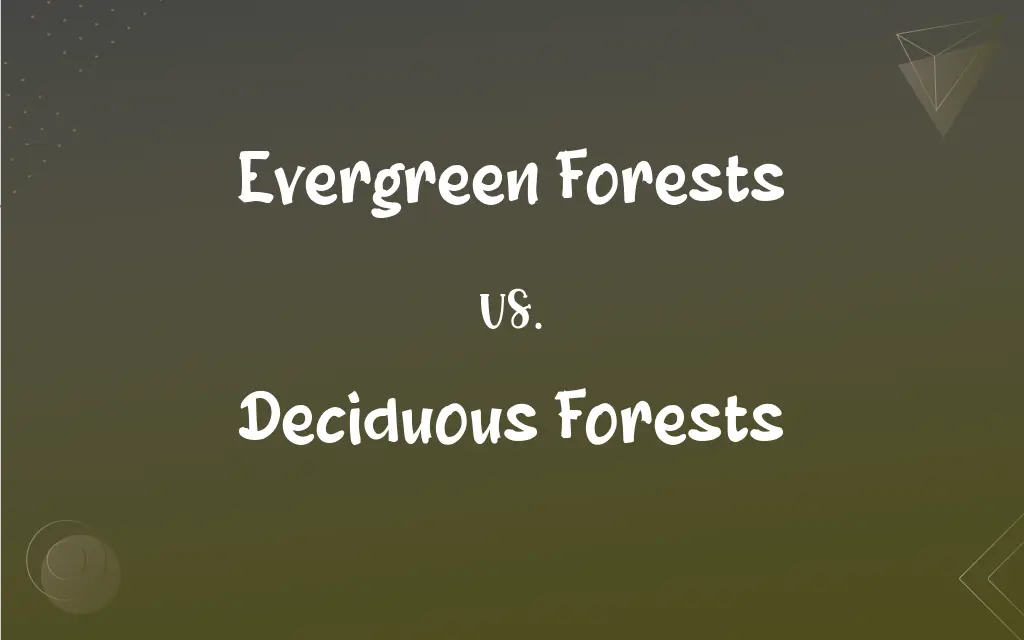Evergreen Forests vs. Deciduous Forests: What's the Difference?
Edited by Janet White || By Harlon Moss || Published on February 27, 2024
Evergreen forests consist of trees that retain their leaves year-round, while deciduous forests have trees that lose their leaves seasonally.

Key Differences
Evergreen forests are characterized by trees that maintain their foliage throughout the year, ensuring a constant green canopy. Deciduous forests, in contrast, are defined by their trees that shed leaves annually, typically in response to colder temperatures, leading to a seasonal transformation in the forest's appearance.
The species in evergreen forests are adapted to less nutrient-rich soils, as their constant foliage allows for year-round photosynthesis. Deciduous forests, however, often exist in more temperate zones where nutrient cycles are aided by the annual leaf drop, enriching the soil.
Evergreen forests often dominate in areas with consistent temperatures and high humidity, such as tropical rainforests and boreal regions. Conversely, deciduous forests are commonly found in regions with distinct seasonal changes, experiencing warm summers and cold winters.
In evergreen forests, the constant leaf cover provides a stable habitat for wildlife throughout the year. Deciduous forests, on the other hand, offer a changing habitat, with varying light and temperature conditions, influencing the diversity and behavior of resident species.
Evergreen forests play a crucial role in carbon sequestration due to their year-long photosynthesis, while deciduous forests contribute significantly to the Earth's carbon cycle through their seasonal leaf turnover and varying photosynthetic rates.
ADVERTISEMENT
Comparison Chart
Leaf Retention
Retain leaves year-round
Shed leaves annually
Climate Adaptation
Suited for consistent temperatures and high humidity
Adapt to regions with distinct seasonal changes
Photosynthesis
Continuous throughout the year
Seasonal, peaking in warmer months
Soil Nutrition
Adapted to less nutrient-rich soils
Contribute to nutrient cycling via leaf drop
Wildlife Habitat
Provide stable conditions year-round
Offer changing habitats with the seasons
ADVERTISEMENT
Carbon Sequestration
High due to constant photosynthesis
Significant through seasonal leaf turnover
Evergreen Forests and Deciduous Forests Definitions
Evergreen Forests
Evergreen forests contribute significantly to the Earth's oxygen supply.
The evergreen forests in the Pacific Northwest are vital for global oxygen production.
Deciduous Forests
Deciduous forests play a key role in the Earth's carbon cycle.
The deciduous forests in Appalachia contribute to carbon cycling through their seasonal leaf shed.
Evergreen Forests
Evergreen forests are comprised of trees that maintain their leaves all year.
The Amazon Rainforest, an evergreen forest, remains lush and green throughout the year.
Deciduous Forests
They offer a varied habitat for wildlife, changing with the seasons.
Animals in deciduous forests, such as those in Japan, adapt to the seasonal shifts in the environment.
Evergreen Forests
These forests are characterized by continuous foliage, unaffected by seasonal changes.
In evergreen forests like those in Canada, trees do not lose their needles in winter.
Deciduous Forests
Deciduous forests often have rich, fertile soils due to the annual leaf drop.
The deciduous forests in France support diverse plant life due to nutrient-rich soil.
Evergreen Forests
They are crucial for sustaining wildlife habitats due to their year-round coverage.
Wildlife in the evergreen forests of the Congo Basin depends on the constant availability of foliage.
Deciduous Forests
Deciduous forests contain trees that lose their leaves annually.
The deciduous forests of New England are famous for their spectacular fall foliage.
Evergreen Forests
Evergreen forests thrive in both tropical and temperate climates, maintaining a consistent canopy.
The Scandinavian evergreen forests remain verdant even during the snowy winters.
Deciduous Forests
These forests experience a transformation with the changing seasons, especially in autumn.
In autumn, deciduous forests like those in Germany turn into a vibrant display of colors.
FAQs
What climates do deciduous forests thrive in?
Deciduous forests thrive in temperate zones with distinct seasonal changes, including warm summers and cold winters.
What defines deciduous forests?
Deciduous forests are characterized by trees that shed their leaves seasonally, often in response to colder temperatures.
Are deciduous forests important for wildlife?
Yes, deciduous forests offer a dynamic habitat that changes with the seasons, supporting diverse wildlife.
How do deciduous forests contribute to the carbon cycle?
Deciduous forests contribute to the carbon cycle through their seasonal leaf turnover and varying photosynthesis rates.
Do evergreen forests change much throughout the year?
No, evergreen forests remain relatively unchanged throughout the year, maintaining constant foliage.
Where are evergreen forests typically found?
Evergreen forests are common in regions with consistent temperatures and high humidity, such as tropical and boreal areas.
How do evergreen forests affect the soil?
Evergreen forests typically exist in less nutrient-rich soils, as their constant leaf cover limits nutrient cycling.
What are evergreen forests?
Evergreen forests consist of trees that retain their leaves throughout the year, providing constant greenery.
How do evergreen forests affect wildlife?
Evergreen forests provide stable habitats for wildlife, offering shelter and food sources throughout the year.
Do deciduous and evergreen forests coexist in some regions?
Yes, in some temperate regions, deciduous and evergreen forests coexist, offering a diverse range of habitats.
Can evergreen forests be found in cold climates?
Yes, certain types of evergreen forests, like boreal forests, thrive in cold climates.
Are deciduous forests more diverse than evergreen forests?
Deciduous forests can have higher biodiversity due to the varied habitats created by seasonal changes.
How do deciduous forests affect local ecosystems?
Deciduous forests impact local ecosystems through their seasonal changes, influencing temperature, light, and soil conditions.
What role do evergreen forests play in carbon sequestration?
Evergreen forests play a significant role in carbon sequestration due to their year-round photosynthesis.
Can evergreen forests be found near the equator?
Yes, tropical evergreen forests are common near the equator.
Are evergreen forests important for global oxygen production?
Yes, evergreen forests contribute significantly to global oxygen production through continuous photosynthesis.
Do evergreen forests have a high level of species adaptation?
Yes, species in evergreen forests are highly adapted to stable, year-round conditions.
What is the most notable seasonal change in deciduous forests?
The most notable change is the shedding of leaves in autumn, leading to a dramatic transformation in the forest's appearance.
What impact does the leaf drop have on deciduous forest soils?
The annual leaf drop in deciduous forests enriches the soil, making it more fertile.
Are deciduous forests more susceptible to climate change?
Deciduous forests may be more affected by climate change due to their reliance on seasonal cues.
About Author
Written by
Harlon MossHarlon is a seasoned quality moderator and accomplished content writer for Difference Wiki. An alumnus of the prestigious University of California, he earned his degree in Computer Science. Leveraging his academic background, Harlon brings a meticulous and informed perspective to his work, ensuring content accuracy and excellence.
Edited by
Janet WhiteJanet White has been an esteemed writer and blogger for Difference Wiki. Holding a Master's degree in Science and Medical Journalism from the prestigious Boston University, she has consistently demonstrated her expertise and passion for her field. When she's not immersed in her work, Janet relishes her time exercising, delving into a good book, and cherishing moments with friends and family.
































































